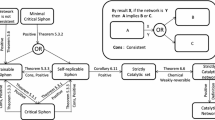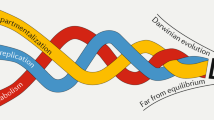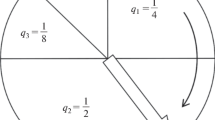Abstract
A generalized model ofn catalytically-coupled self-replicative molecules witherror-prone replication is presented. A generalized mathematical formulation of this model and the outline of its asymptotic behaviour have been developed. Due to the complexity of the model, only in simple situations is it possible to draw general conclusions from the standard analysis. Some complex situations are illustrated by means of numerical integration of particular examples.
Similar content being viewed by others
Literature
Andrade, M. A., A. Garcia-Tejedor and F. Montero. 1991. Study of an error-prone hypercycle formed from two kinetically distinguishable species.Biophys. Chem. 40, 43–57.
Andrade, M.A., J.C. Nuño, F. Morán, F. Montero and G. J. Mpitsos. 1992. Complex dynamics of a catalytic network having faulty replication into an error species. Preprint.
Cech, T. R. and B. L. Bass. 1986. Biological catalysis by RNA.A. Rev. Biochem. 55, 599–630.
Cech, T. R. 1989. Ribozyme self-replication?Nature 339, 507–508.
Cech, T. R. 1990. Self-splicing of group I introns.A. Rev. Biochem. 59, 543–568.
Doudna, J. A. and J. W. Szostak. 1989. RNA-catalysed synthesis of complementary-strand RNA.Nature 339, 519–522.
Eigen, M. 1971. Self-organization of matter and the evolution of biological macromolecules.Naturwissenschaften 58, 465–523.
Eigen, M. and P. Schuster. 1979.The Hypercycle—A Principle of Natural Self-Organization. Berlin: Springer-Verlag.
Eigen, M., J. McCaskill and P. Schuster. 1989. The molecular quasi-species.Adv. Chem. Phys. 75, 149–263.
Farmer, J. D., S. A. Kauffman and N. H. Packard. 1986a. Autocatalytic replication of polymers.Physica D 22, 50–67.
Farmer, J. D., N. H. Packard and A. S. Perelson. 1986b. The immune system, adaptation, and machine learning.Physica D 22, 187–204.
Farmer, J. D. 1990. A rosetta stone for connectionism.Physica D 42, 153–187.
García-Tejedor, A., F. Morán and F. Montero. 1987. Influence of the hypercyclic organization on the error threshold.J. theor. Biol. 127, 393–402.
García-Tejedor, A., J. C. Sanz-Nuño, J. Olarrea, F. J. De la Rubia and F. Montero. 1988. Influence of the hypercycle on the error threshold: a stochastic approach.J. theor. Biol. 134, 431–443.
Hadeler, K. P. 1981. Stable polymorfisms in a selection model with mutation.SIAM J. appl. Math. 41, 1–7.
Hofbauer, J., P. Schuster, K. Sigmund and R. Wolff. 1980. Dynamical systems under constant organization II: homogeneous growth functions of degreep=2.SIAM J. appl. Math. 38, 282–304.
Hofbauer, J. 1985. The selection mutation equation.J. math. Biol. 23, 41–53.
Hofbauer, J. and K. Sigmund. 1988.The Theory of Evolution and Dynamical Systems. Cambridge, U.K., Cambridge University Press.
Küppers, B. O. 1983.Molecular Theory of Evolution, Berlin: Springer-Verlag.
Nowak, M. and P. Schuster. 1989. Error thresholds of replication in finite populations mutation frequencies and the onset of Muller's ratchet.J. theor. Biol. 137, 375–395.
Parisi, G. 1990. A simple model for the immune network.PNAS 87, 429–433.
Schnabl, W., P. F. Stadler, C. Forst and P. Schuster. 1991. Full characterization of a strange attractor.Physica D 48, 65–90.
Schuster, P., K. Sigmund and R. Wolff. 1979. Dynamical systems under constant organization. III. Cooperative and competitive behavior of hypercycles.J. diff. Eq. 32, 357–368.
Schuster, P. 1986. Dynamics of molecular evolution.Physica D 22, 100–119.
Schuster, P. 1987. Structure and dynamics of replication mutation systems.Phys. Scripta 35, 402–416.
Stadler, P. F. and P. Schuster. 1990. Dynamics of small autocatalytic reaction networks—I. Bifurcations, permanence and exclusion.Bull. math. Biol. 53, 485–508.
Stadler, P. F. and P. Schuster. 1992. Mutation in autocatalytic reaction networks: an analysis based on perturbation theory.J. math. Biol., to appear.
Stadler, P. F., W. Schnabl, C. Forst and P. Schuster. 1990.Math. Biosci., submitted.
Swetina, J. and P. Schuster. 1982. Self-replication with errors. A model for polynucleotide replication.Biophys. Chem. 16, 329–345.
Author information
Authors and Affiliations
Corresponding author
Rights and permissions
About this article
Cite this article
Nuño, J.C., Andrade, M.A., Morán, F. et al. A model of an autocatalytic network formed by error-prone self-replicative species. Bltn Mathcal Biology 55, 385–415 (1993). https://doi.org/10.1007/BF02460889
Received:
Revised:
Issue Date:
DOI: https://doi.org/10.1007/BF02460889




